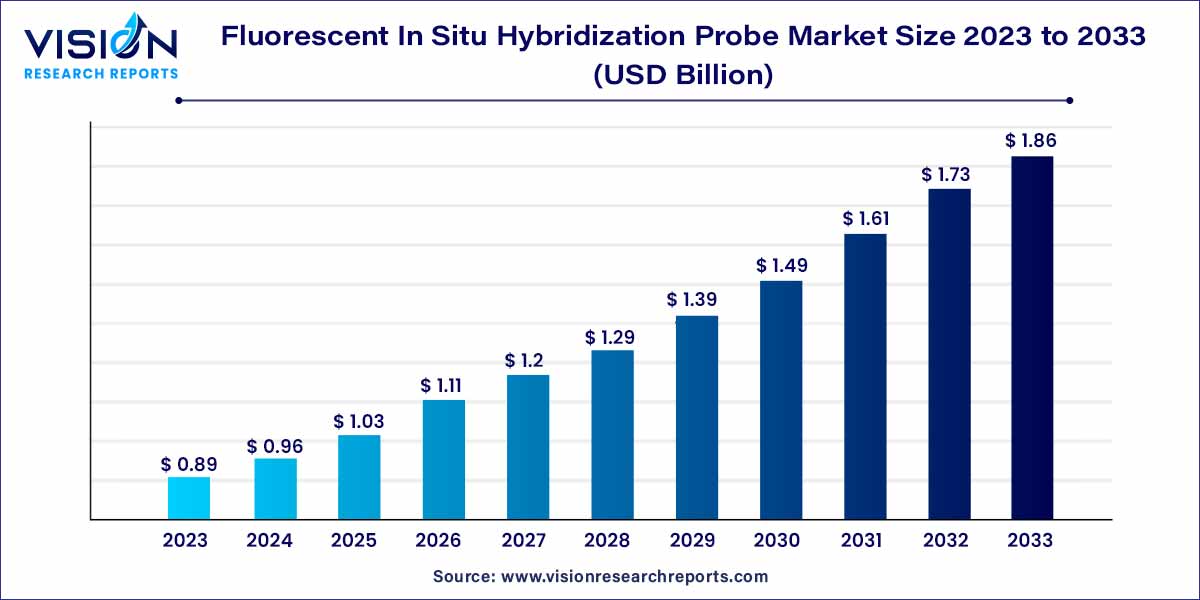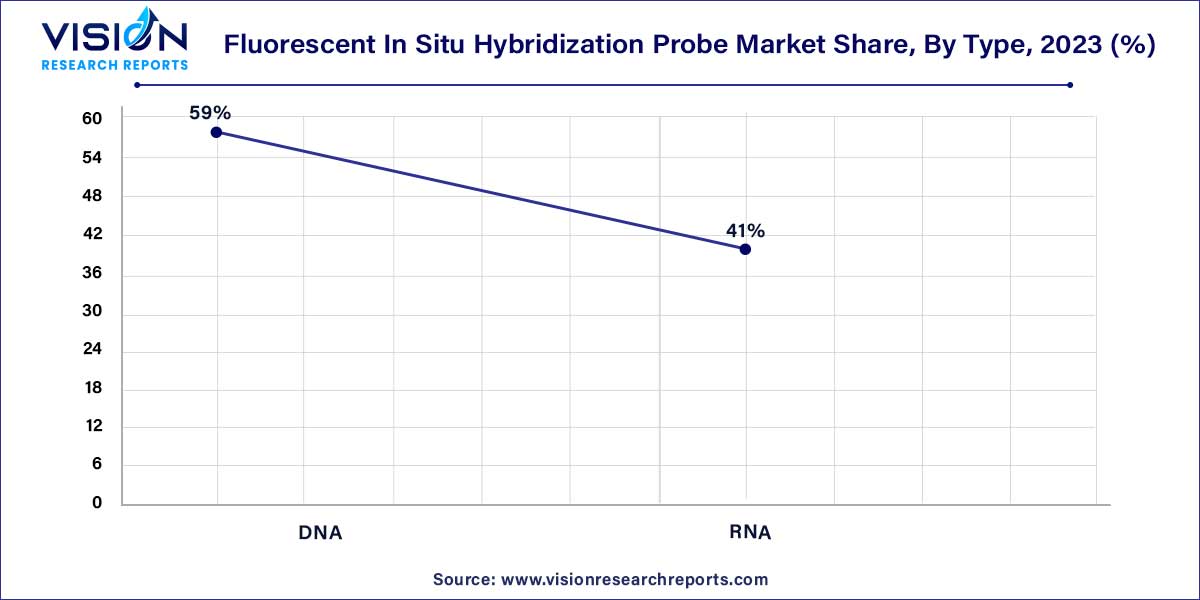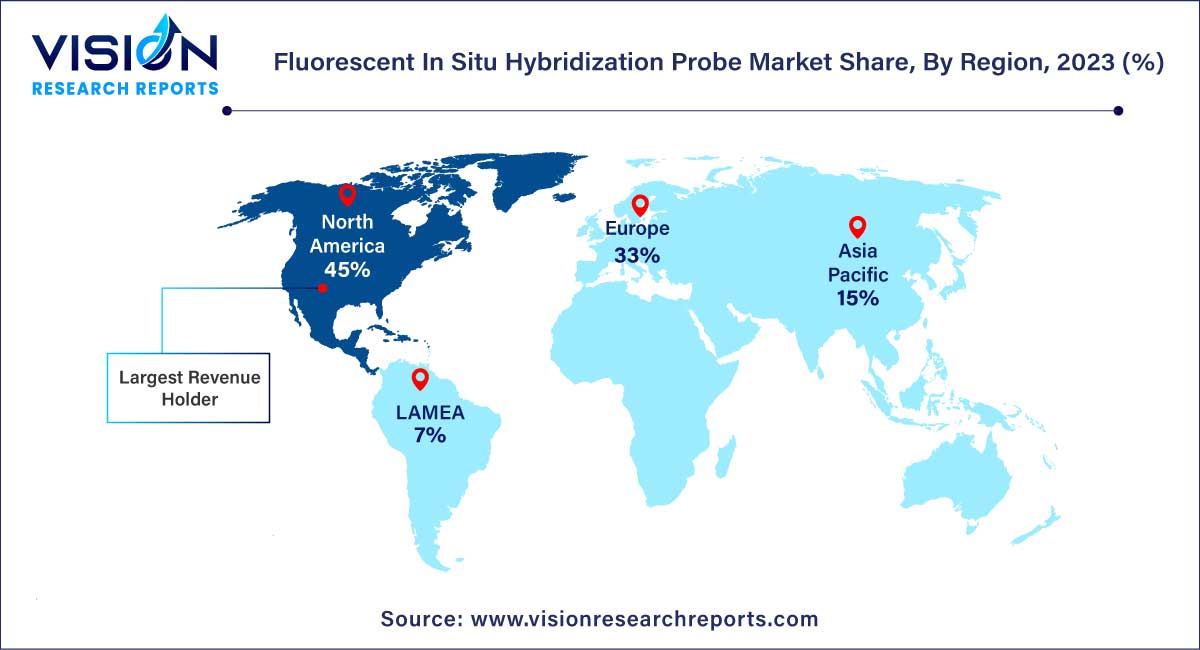The global fluorescent in situ hybridization probe market size was estimated at USD 0.89 billion in 2023 and it is expected to surpass around USD 1.86 billion by 2033, poised to grow at a CAGR of 7.65% from 2024 to 2033.

Fluorescent in situ hybridization (FISH) probes have become instrumental in the realm of molecular biology, revolutionizing the way researchers and clinicians explore the intricacies of the genome. This overview provides a comprehensive insight into the key facets shaping the fluorescent in situ hybridization probe market.
The growth of the fluorescent in situ hybridization probe market is propelled by several key factors. Firstly, the increasing demand for comprehensive genomic analysis in both research and clinical applications has significantly contributed to the market's expansion. The versatility of fluorescent in situ hybridization (FISH) probes allows for precise mapping of genetic elements, addressing the growing need for detailed genomic information. Secondly, the expanding applications of FISH probes in diagnostics, particularly in the identification of genetic disorders and various types of cancers, have positioned them as integral tools in routine clinical practices.
| Report Coverage | Details |
| Market Revenue by 2033 | USD 1.86 billion |
| Growth Rate from 2024 to 2033 | CAGR of 7.65% |
| Revenue Share of North America in 2023 | 45% |
| Base Year | 2023 |
| Forecast Period | 2024 to 2033 |
| Market Analysis (Terms Used) | Value (US$ Million/Billion) or (Volume/Units) |
The FLOW-FISH segment held the largest revenue share of 36% in 2023 and is anticipated to grow at the fastest growth rate over the forecast period. This is owing to the growing demand for genomic profiling by healthcare professionals. Flow FISH testing can automatically screen over 10,000 cells in around 10 minutes. This approach, in addition to improving testing efficiency and standardization, achieves greater repeatability than traditional manual FISH testing by measuring 20 to 100 times more cells.
This is particularly important in fields, such as cancer research and immunology. The rising prevalence of chromosomal disorders is propelling the need for the product in the market. The technique is constantly being adopted for the diagnosis of Dyskeratosis congenita, the first inheritable disorder that is associated with the impaired maintenance of telomere. It is a rare condition that generally shows high prevalence in patients with bone marrow failure.
The DNA segment contributed the largest market share of 59% in 2023 due to the rising demand for molecular profiling by healthcare professionals and the presence of molecular pathology tools that are technologically advanced and help in disease stratification and prognosis for appropriate treatment. The development of technologically advanced diagnostics tools is enabling the adoption of DNA probes in the market. For instance, in July 2023, KromaTiD announced the development of over 300 telomere, centromere, and gene probes for use in directional Genomic Hybridization (dGH) in-site DNA assays. The availability of a catalog of centromere and telomere probes empowers researchers and cytogenetic cores within the academic sphere to adopt these potent and advanced assays within their own facilities, all while maintaining cost-effectiveness.

The RNA probes segment is anticipated to register the fastest growth rate over the forecast period owing to the rising use of RNA probes for cancer analysis and the ability of RNA probes to differentiate between cancer subtypes. Novel probes targeting disease-specific RNA are being developed by companies, such as the Stellaris RNA probe by BioSearch technologies and the RNAscope series by Advanced Cell Diagnostics for infectious diseases and cancer.
The cancer diagnostics segment generated the maximum market share of 44% in 2023. FISH probes are most commonly used in research for genetic diseases and cancer diagnostics. Increasing cancer incidences across the globe, which lead to the rising demand for sensitive, rapid, and accurate molecular diagnostic tests, are propelling the market growth. In cancer diagnostics, these probes are widely used for the diagnosis of breast and lung cancer. The development of novel diagnostics using FISH technology is further driving market growth. For instance, the UroVysion FISH test kit is used for the diagnosis of urological cancers.
On the other hand, owing to its advantages of exceptional detection precision, heightened sensitivity, and robust experimental duration, the utilization of FISH technology coupled with a fluorescent microscope has progressively enhanced the preference of these probes in cytogenetic analysis. FISH demonstrates remarkable efficacy in identifying anomalies within the MET (hepatocyte growth receptor factor) gene in non-small cell lung cancer as well as in detecting genes related to breast cancer. These factors aided by the high sensitivity and efficient testing capabilities associated with FISH probes are anticipated to drive the growth of the cancer diagnostics application segment.
The clinical use segment dominated the market with a revenue share of 42% in 2023 due to the wide application of FISH probes in the detection and diagnosis of genetic disorders, cancer, and infectious diseases. Fluorescence in situ hybridization is a commonly adopted technology used for the diagnosis of genetic abnormalities. They are commonly used in clinical procedures, companion diagnostics, and research studies. The specificity & high sensitivity of this technology and the rapid assays performing speed have made this technique an important cytogenetic test that offers significant benefits in research and diagnostic studies of hematological malignancies and solid tumors.
These probes are used in research studies for gene mapping, genetic aberrations, and the identification of novel oncogenes in cancer detection and treatment. It is also used in molecular-based testing for gene mapping and identification of novel oncogenes. The clinical and microbiological detection approaches have been greatly influenced by FISH, largely attributed to its high specificity and efficiency. This makes the technology one of the most commonly adopted techniques for clinical microbiological detection.
North America accounted for the largest revenue share of 45% in 2023. The dominance of the region is attributed to the rising prevalence of genetic disorders leading to birth defects, developmental disabilities, and other metabolic syndromes. According to the CDC, in 2022, around 3-4% of newborns in the U.S. were born with some form of genetic abnormality, accounting for hospitalization of approximately 10% of adults and 30% of children. FISH is estimated to provide 98% accuracy in the detection of chromosomal aberrations leading to genetic abnormalities, which further propels the growth of the market in the region.

Moreover, usage of these assays in various disease areas, such as cancer and genetic disorders, is increasing and is further anticipated to drive the demand. Favorable healthcare reimbursement policies and government reforms are anticipated to fuel market growth. Asia Pacific is anticipated to register the fastest growth rate over the coming years on account of the presence of supportive government initiatives pertaining to the increasing investments by the government and key manufacturers in the biotechnology sector posing high untapped opportunities the for development of novel diagnostics in the region.
By Technology
By Type
By Application
By End-Use
By Regional
Chapter 1. Introduction
1.1. Research Objective
1.2. Scope of the Study
1.3. Definition
Chapter 2. Research Methodology
2.1. Research Approach
2.2. Data Sources
2.3. Assumptions & Limitations
Chapter 3. Executive Summary
3.1. Market Snapshot
Chapter 4. Market Variables and Scope
4.1. Introduction
4.2. Market Classification and Scope
4.3. Industry Value Chain Analysis
4.3.1. Raw Material Procurement Analysis
4.3.2. Sales and Distribution Channel Analysis
4.3.3. Downstream Buyer Analysis
Chapter 5. COVID 19 Impact on Fluorescent In Situ Hybridization Probe Market
5.1. COVID-19 Landscape: Fluorescent In Situ Hybridization Probe Industry Impact
5.2. COVID 19 - Impact Assessment for the Industry
5.3. COVID 19 Impact: Global Major Government Policy
5.4. Market Trends and Opportunities in the COVID-19 Landscape
Chapter 6. Market Dynamics Analysis and Trends
6.1. Market Dynamics
6.1.1. Market Drivers
6.1.2. Market Restraints
6.1.3. Market Opportunities
6.2. Porter’s Five Forces Analysis
6.2.1. Bargaining power of suppliers
6.2.2. Bargaining power of buyers
6.2.3. Threat of substitute
6.2.4. Threat of new entrants
6.2.5. Degree of competition
Chapter 7. Competitive Landscape
7.1.1. Company Market Share/Positioning Analysis
7.1.2. Key Strategies Adopted by Players
7.1.3. Vendor Landscape
7.1.3.1. List of Suppliers
7.1.3.2. List of Buyers
Chapter 8. Global Fluorescent In Situ Hybridization Probe Market, By Technology
8.1. Fluorescent In Situ Hybridization Probe Market, by Technology, 2024-2033
8.1.1. Flow FISH
8.1.1.1. Market Revenue and Forecast (2021-2033)
8.1.2. Q FISH
8.1.2.1. Market Revenue and Forecast (2021-2033)
8.1.3. Other FISH
8.1.3.1. Market Revenue and Forecast (2021-2033)
Chapter 9. Global Fluorescent In Situ Hybridization Probe Market, By Type
9.1. Fluorescent In Situ Hybridization Probe Market, by Type, 2024-2033
9.1.1. DNA
9.1.1.1. Market Revenue and Forecast (2021-2033)
9.1.2. RNA
9.1.2.1. Market Revenue and Forecast (2021-2033)
Chapter 10. Global Fluorescent In Situ Hybridization Probe Market, By Application
10.1. Fluorescent In Situ Hybridization Probe Market, by Application, 2024-2033
10.1.1. Cancer Research
10.1.1.1. Market Revenue and Forecast (2021-2033)
10.1.2. Genetic Diseases
10.1.2.1. Market Revenue and Forecast (2021-2033)
10.1.3. Other
10.1.3.1. Market Revenue and Forecast (2021-2033)
Chapter 11. Global Fluorescent In Situ Hybridization Probe Market, By End-Use
11.1. Fluorescent In Situ Hybridization Probe Market, by End-Use, 2024-2033
11.1.1. Research
11.1.1.1. Market Revenue and Forecast (2021-2033)
11.1.2. Clinical
11.1.2.1. Market Revenue and Forecast (2021-2033)
11.1.3. Companion diagnostics
11.1.3.1. Market Revenue and Forecast (2021-2033)
Chapter 12. Global Fluorescent In Situ Hybridization Probe Market, Regional Estimates and Trend Forecast
12.1. North America
12.1.1. Market Revenue and Forecast, by Technology (2021-2033)
12.1.2. Market Revenue and Forecast, by Type (2021-2033)
12.1.3. Market Revenue and Forecast, by Application (2021-2033)
12.1.4. Market Revenue and Forecast, by End-Use (2021-2033)
12.1.5. U.S.
12.1.5.1. Market Revenue and Forecast, by Technology (2021-2033)
12.1.5.2. Market Revenue and Forecast, by Type (2021-2033)
12.1.5.3. Market Revenue and Forecast, by Application (2021-2033)
12.1.5.4. Market Revenue and Forecast, by End-Use (2021-2033)
12.1.6. Rest of North America
12.1.6.1. Market Revenue and Forecast, by Technology (2021-2033)
12.1.6.2. Market Revenue and Forecast, by Type (2021-2033)
12.1.6.3. Market Revenue and Forecast, by Application (2021-2033)
12.1.6.4. Market Revenue and Forecast, by End-Use (2021-2033)
12.2. Europe
12.2.1. Market Revenue and Forecast, by Technology (2021-2033)
12.2.2. Market Revenue and Forecast, by Type (2021-2033)
12.2.3. Market Revenue and Forecast, by Application (2021-2033)
12.2.4. Market Revenue and Forecast, by End-Use (2021-2033)
12.2.5. UK
12.2.5.1. Market Revenue and Forecast, by Technology (2021-2033)
12.2.5.2. Market Revenue and Forecast, by Type (2021-2033)
12.2.5.3. Market Revenue and Forecast, by Application (2021-2033)
12.2.5.4. Market Revenue and Forecast, by End-Use (2021-2033)
12.2.6. Germany
12.2.6.1. Market Revenue and Forecast, by Technology (2021-2033)
12.2.6.2. Market Revenue and Forecast, by Type (2021-2033)
12.2.6.3. Market Revenue and Forecast, by Application (2021-2033)
12.2.6.4. Market Revenue and Forecast, by End-Use (2021-2033)
12.2.7. France
12.2.7.1. Market Revenue and Forecast, by Technology (2021-2033)
12.2.7.2. Market Revenue and Forecast, by Type (2021-2033)
12.2.7.3. Market Revenue and Forecast, by Application (2021-2033)
12.2.7.4. Market Revenue and Forecast, by End-Use (2021-2033)
12.2.8. Rest of Europe
12.2.8.1. Market Revenue and Forecast, by Technology (2021-2033)
12.2.8.2. Market Revenue and Forecast, by Type (2021-2033)
12.2.8.3. Market Revenue and Forecast, by Application (2021-2033)
12.2.8.4. Market Revenue and Forecast, by End-Use (2021-2033)
12.3. APAC
12.3.1. Market Revenue and Forecast, by Technology (2021-2033)
12.3.2. Market Revenue and Forecast, by Type (2021-2033)
12.3.3. Market Revenue and Forecast, by Application (2021-2033)
12.3.4. Market Revenue and Forecast, by End-Use (2021-2033)
12.3.5. India
12.3.5.1. Market Revenue and Forecast, by Technology (2021-2033)
12.3.5.2. Market Revenue and Forecast, by Type (2021-2033)
12.3.5.3. Market Revenue and Forecast, by Application (2021-2033)
12.3.5.4. Market Revenue and Forecast, by End-Use (2021-2033)
12.3.6. China
12.3.6.1. Market Revenue and Forecast, by Technology (2021-2033)
12.3.6.2. Market Revenue and Forecast, by Type (2021-2033)
12.3.6.3. Market Revenue and Forecast, by Application (2021-2033)
12.3.6.4. Market Revenue and Forecast, by End-Use (2021-2033)
12.3.7. Japan
12.3.7.1. Market Revenue and Forecast, by Technology (2021-2033)
12.3.7.2. Market Revenue and Forecast, by Type (2021-2033)
12.3.7.3. Market Revenue and Forecast, by Application (2021-2033)
12.3.7.4. Market Revenue and Forecast, by End-Use (2021-2033)
12.3.8. Rest of APAC
12.3.8.1. Market Revenue and Forecast, by Technology (2021-2033)
12.3.8.2. Market Revenue and Forecast, by Type (2021-2033)
12.3.8.3. Market Revenue and Forecast, by Application (2021-2033)
12.3.8.4. Market Revenue and Forecast, by End-Use (2021-2033)
12.4. MEA
12.4.1. Market Revenue and Forecast, by Technology (2021-2033)
12.4.2. Market Revenue and Forecast, by Type (2021-2033)
12.4.3. Market Revenue and Forecast, by Application (2021-2033)
12.4.4. Market Revenue and Forecast, by End-Use (2021-2033)
12.4.5. GCC
12.4.5.1. Market Revenue and Forecast, by Technology (2021-2033)
12.4.5.2. Market Revenue and Forecast, by Type (2021-2033)
12.4.5.3. Market Revenue and Forecast, by Application (2021-2033)
12.4.5.4. Market Revenue and Forecast, by End-Use (2021-2033)
12.4.6. North Africa
12.4.6.1. Market Revenue and Forecast, by Technology (2021-2033)
12.4.6.2. Market Revenue and Forecast, by Type (2021-2033)
12.4.6.3. Market Revenue and Forecast, by Application (2021-2033)
12.4.6.4. Market Revenue and Forecast, by End-Use (2021-2033)
12.4.7. South Africa
12.4.7.1. Market Revenue and Forecast, by Technology (2021-2033)
12.4.7.2. Market Revenue and Forecast, by Type (2021-2033)
12.4.7.3. Market Revenue and Forecast, by Application (2021-2033)
12.4.7.4. Market Revenue and Forecast, by End-Use (2021-2033)
12.4.8. Rest of MEA
12.4.8.1. Market Revenue and Forecast, by Technology (2021-2033)
12.4.8.2. Market Revenue and Forecast, by Type (2021-2033)
12.4.8.3. Market Revenue and Forecast, by Application (2021-2033)
12.4.8.4. Market Revenue and Forecast, by End-Use (2021-2033)
12.5. Latin America
12.5.1. Market Revenue and Forecast, by Technology (2021-2033)
12.5.2. Market Revenue and Forecast, by Type (2021-2033)
12.5.3. Market Revenue and Forecast, by Application (2021-2033)
12.5.4. Market Revenue and Forecast, by End-Use (2021-2033)
12.5.5. Brazil
12.5.5.1. Market Revenue and Forecast, by Technology (2021-2033)
12.5.5.2. Market Revenue and Forecast, by Type (2021-2033)
12.5.5.3. Market Revenue and Forecast, by Application (2021-2033)
12.5.5.4. Market Revenue and Forecast, by End-Use (2021-2033)
12.5.6. Rest of LATAM
12.5.6.1. Market Revenue and Forecast, by Technology (2021-2033)
12.5.6.2. Market Revenue and Forecast, by Type (2021-2033)
12.5.6.3. Market Revenue and Forecast, by Application (2021-2033)
12.5.6.4. Market Revenue and Forecast, by End-Use (2021-2033)
Chapter 13. Company Profiles
13.1. Thermo Fisher Scientific Inc.
13.1.1. Company Overview
13.1.2. Product Offerings
13.1.3. Financial Performance
13.1.4. Recent Initiatives
13.2. Perkinelmer Inc.
13.2.1. Company Overview
13.2.2. Product Offerings
13.2.3. Financial Performance
13.2.4. Recent Initiatives
13.3. BioDot
13.3.1. Company Overview
13.3.2. Product Offerings
13.3.3. Financial Performance
13.3.4. Recent Initiatives
13.4. Horizon Diagnostics
13.4.1. Company Overview
13.4.2. Product Offerings
13.4.3. Financial Performance
13.4.4. Recent Initiatives
13.5. Agilent Technologies, Inc.
13.5.1. Company Overview
13.5.2. Product Offerings
13.5.3. Financial Performance
13.5.4. Recent Initiatives
13.6. Abnova Corporation
13.6.1. Company Overview
13.6.2. Product Offerings
13.6.3. Financial Performance
13.6.4. Recent Initiatives
13.7. LGC Biosearch Technologies
13.7.1. Company Overview
13.7.2. Product Offerings
13.7.3. Financial Performance
13.7.4. Recent Initiatives
13.8. Genemed Biotechnologies, Inc.
13.8.1. Company Overview
13.8.2. Product Offerings
13.8.3. Financial Performance
13.8.4. Recent Initiatives
13.9. Oxford Gene Technology IP Limited
13.9.1. Company Overview
13.9.2. Product Offerings
13.9.3. Financial Performance
13.9.4. Recent Initiatives
13.10. Biocare Medical, LLC.
13.10.1. Company Overview
13.10.2. Product Offerings
13.10.3. Financial Performance
13.10.4. Recent Initiatives
Chapter 14. Research Methodology
14.1. Primary Research
14.2. Secondary Research
14.3. Assumptions
Chapter 15. Appendix
15.1. About Us
15.2. Glossary of Terms
 Cross-segment Market Size and Analysis for
Mentioned Segments
Cross-segment Market Size and Analysis for
Mentioned Segments
 Additional Company Profiles (Upto 5 With No Cost)
Additional Company Profiles (Upto 5 With No Cost)
 Additional Countries (Apart From Mentioned Countries)
Additional Countries (Apart From Mentioned Countries)
 Country/Region-specific Report
Country/Region-specific Report
 Go To Market Strategy
Go To Market Strategy
 Region Specific Market Dynamics
Region Specific Market Dynamics Region Level Market Share
Region Level Market Share Import Export Analysis
Import Export Analysis Production Analysis
Production Analysis Others
Others